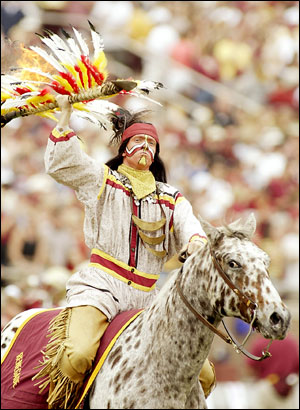So far, designs have featured Agriculture with the “Three Sisters” method of planting, Government with the Haudenosaunee or Iroquois Confederacy, and Diplomacy with the written peace treaty between Native Americans and the settlers at Plymouth.
The 2012 Native American Dollar design will feature trade routes of the 17th century and the spread of the horse. The United States Mint recently provided the thirteen design candidates for coin. Some of the designs are traditional depictions while others are done in the style of Native American ledger art.
So the design will "feature trade routes of the 17th century and the spread of the horse"? A few problems with this. There's nothing to signify trade routes in the designs. With all the images of lone warriors and buffalo hunters, these designs have nothing to do with trading parties. What they're conveying is the same Western "romance" seen in countless examples of kitschy art.
Moreover, the Plains horse culture didn't reach fruition until the 19th century. And ledger art didn't exist until the late 19th century. So the coins are using stereotypical images from the wrong era to promote the alleged topic.
Vote early and often
I suggest you go to this site and vote. And don't pick design #8--possibly the worst of the bunch--which is leading at the moment.

(Bad choice.)
I picked #11, but it was a tough choice among the final five ledger painting-style images. Any of them would be okay.

(Good choice.)
Any choice featuring a realistic Indian chief on horseback should be disqualified immediately as stereotypical. That's almost literally the last things that should appear on a Native American coin.
The ledger art adds a dimension of information and art to the subject. Even though some of the realistic images are good, the choice should be a ledger painting.
Why no contemporary Indians?
Someone questioned the idea of putting any historical Native images on coins because they have nothing to do with "contemporary Indian realities." My response:
Well, they can't put living subjects on US coins by law. Historical subjects are the norm, although they did reference the moon landing once.
I presumed they were going through Native history chronologically and would get to modern history eventually. Maybe the Indian Citizenship Act, the civil rights movement, or Wilma Mankiller to represent today's tribal leadership. Things like that.
Instead they jumped from the Pilgrims to the Plains culture of the mid-19th century. Are they gonna backtrack and cover the 250 years they missed? Or is the series turning into a Native "greatest hits"? Corn, Hiawatha, Pilgrims, Plains chiefs...let's hope the next coin isn't Iron Eyes Cody crying over the environment.
Was it a mistake?
I wonder if the "17th century" part was a typo for "19th century." Who knows much about 17th-century trade routes and the spread of horse culture? I'm thinking most 17th-century trading was done on foot or in canoes.
In that century, I believe the Iroquois (Haudenosaunee) traveled west to the Ohio Valley and south to Virginia and the Carolinas. But more to raid and skirmish than to trade. Various Algonquian and Great Lakes tribes accompanied the French on exploring and trapping missions down the Mississippi River. The Europeans may have used horses during this period, but I doubt the Indians did.
Meanwhile, the Spanish were establishing colonies in the Southwest and Southeast. I believe they were the main contributors of horses to the Plains culture. But I'm not sure they did much trading. They were more into subjugating, enslaving, and converting Indians than trading with them.
So which trade routes are we talking about? Which horse culture? And what's the connection with 19th-century Plains chiefs, warriors, and ledger art? The whole thing doesn't make sense.
For more on the Sacagawea dollar, see 2011 Sacagawea Dollar Reverse Unveiled and 2nd Sacagawea Dollar Reverse Unveiled.
Below: This isn't a stereotypical chief either. It's a lesson about the trade routes of the 17th century and the spread of the horse. Yeah, right.


No comments:
Post a Comment
Note: Only a member of this blog may post a comment.